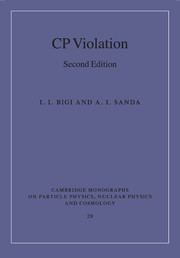Book contents
- Frontmatter
- Contents
- Preface to the second edition
- Preface to the first edition
- Part I Basics of CP violation
- Part II Theory and experiments
- Part III Looking beyond the Standard Model
- 16 Quest for CP violation in the neutrino sector
- 17 Possible corrections to the KM ansatz: right-handed currents and non-minimal Higgs dynamics
- 18 CP violation without non-perturbative dynamics – top quarks and charged leptons
- 19 SUSY-providing shelter for Higgs dynamics
- 20 Minimal flavour violation and extra dimensions
- 21 Baryogenesis in the universe
- Part IV Summary
- References
- Index
17 - Possible corrections to the KM ansatz: right-handed currents and non-minimal Higgs dynamics
Published online by Cambridge University Press: 10 March 2010
- Frontmatter
- Contents
- Preface to the second edition
- Preface to the first edition
- Part I Basics of CP violation
- Part II Theory and experiments
- Part III Looking beyond the Standard Model
- 16 Quest for CP violation in the neutrino sector
- 17 Possible corrections to the KM ansatz: right-handed currents and non-minimal Higgs dynamics
- 18 CP violation without non-perturbative dynamics – top quarks and charged leptons
- 19 SUSY-providing shelter for Higgs dynamics
- 20 Minimal flavour violation and extra dimensions
- 21 Baryogenesis in the universe
- Part IV Summary
- References
- Index
Summary
As described before, CKM dynamics have passed their greatest challenge so far with flying colours. From a tiny CP asymmetry in K0 decays it had been inferred that certain decays of B mesons exhibit CP asymmetries larger by two orders of magnitude. This prediction has been validated experimentally. At least the bulk of the observed effects is fully consistent with CKM dynamics as embedded within the SM. With the ‘battle for supremacy’ decided in favour of CKM theory, what remains to be settled is the question whether additional layers of dynamics are needed to describe CP violation. There is no direct evidence for the presence of New Physics in the decays of K, B and D mesons. On the other hand we know there must be a new source of CP violation, if baryogenesis has occurred in our universe, i.e. if the observed baryon number is not merely an arbitrary initial value of our universe.
We will discuss two generic corrections to the KM ansatz in this chapter. The first class – models with right-handed currents – has intriguing theoretical features, whereas the second class – a non-minimal Higgs sector – might be seen as an exercise in theoretical engineering. Yet the latter's redeeming feature is that it can find a natural habitat in supersymmetric extensions of the SM. Both scenarios had originally been introduced as competitors for the CKM ansatz and therefore had been calibrated to reproduce ∈K. We will sketch this early history, since we view it as of theoretical interest. Furthermore, some of the technical considerations might become relevant again in the future. These possible corrections tend to leave a relatively small footprint in B decays.
- Type
- Chapter
- Information
- CP Violation , pp. 362 - 395Publisher: Cambridge University PressPrint publication year: 2009



